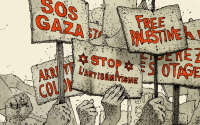Fernand Braudel Center, Binghamton UniversityCommentary No. 122Oct. 1, 2003
Cancun is more than just a passing geopolitical battle. It represents the interment of a neo-liberal offensive that started in the 1970s. To understand the importance of the event, we have to go back to the beginning.
The 1970s marks a turning-point in two cyclical rhythms of the capitalist world-economy. It was the beginning of a long stagnation of the world-economy, a Kondratieff-B phase, out of which we have not yet come. And it marks the moment when the hegemony of the United States in the world-system began to decline. Stagnations in the world-economy mean that the rate of profit has gone down to an important degree, as a result of increased competition in the leading industries and a consequent overproduction. This leads to two kinds of geoeconomic battles: a struggle among the centers of capital accumulation (the United States, western Europe, and Japan/East Asia) to shift the burden of lowered rates of profit to each other. I call this "exporting unemployment," and it has been going on for thirty years, with each of the three centers doing better at different times (Europe in the 1970s, Japan in the 1980s, and the U.S. in the late 1990s).
The second geoeconomic battle however is that between the center and the periphery, the North and the South, in which the North seeks to take back from the South whatever small gains they made during the preceding Kondratieff A-period of expansion (ca. 1945-1970). As everyone knows, Latin America, Africa, eastern Europe, and South Asia all for the most part did poorly after 1970. The only area in the South that did relatively well was eastern and southeast Asia, at least until the financial crisis of the late 1990s. But one area of the periphery always does well in a downturn, since there has to be some region into which declining industries move.
In this difficult period when capitalists were scrambling to maintain their income, partially through relocation of production but more often through financial speculation, they started what can only be called a counteroffensive against the gains of the South and of the working classes in the North in the previous A-period. This came to be called "neo-liberalism." The political face of this counteroffensive was to be found first of all in the transformation of the British Conservative Party and the U.S. Republican Party from a party of moderate Keynesians to a party of ferocious believers in the nostrums of Milton Friedman. Mrs. Thatcher's years as Prime Minister and Ronald Reagan's term as President of the United States represented a distinct turn to the right in both national and world policy, but even more importantly a transformation of their own party structures, as the basis of pushing the balance-point of internal politics from the center to considerably right of center. The new conservative policy constituted a pushback on all three sources of rising cost for producers: wages, the internalization of costs to reduce ecological damage, and state taxation to finance the welfare state.
There was an attempt to coordinate this policy throughout the countries of the North by creating a series of new institutions, notably the Trilateral Commission, the G-7, and the World Economic Forum of Davos. The economic policy that was proposed came to called the Washington Consensus. First of all, we should note the Washington Consensus replaced something called developmentalism. Developmentalism had been the reigning world economic policy in the previous period (in the late 1960s the United Nations had even proclaimed that the 1970s would be the "Decade of Development"). The basic premise of developmentalism had been that every country could "develop," if only its state would implement appropriate policies, and the end point would be a world of states all looking more or less the same and all more or less equally wealthy. Of course, developmentalism did not work, could not work, which sad reality became clear to everyone in the 1970s.
In its place, the Washington Consensus proclaimed that the world was in the era of "globalization." Globalization was said to be the triumph of the free market, the radical reduction of the economic role of the state, and above all, the elimination of all state-created barriers to trans-border movements of goods and capital. The Washington Consensus ordained that the prime role of governments, especially those in the South, was to end the illusions of developmentalism, and accept the unrestricted opening of their frontiers. Mrs. Thatcher trumpeted that they had no choice. She said: TINA, there is no alternative. TINA meant that any government that did not conform would be punished, first of all by the world market and second of all by interstate institutions.
There has been insufficient attention to the fact that it was only beginning in the 1970s that interstate institutions began to play a significant role in these geoeconomic struggles. The International Monetary Fund (IMF) and the World Bank were turned into very active enforcers of the Washington Consensus. They could play this role because the states of the South, grievously hurt by the stagnation of the world-economy, were short on funds and had to turn constantly to outside lenders to compensate for a negative balance of payments. The IMF in particular imposed drastic conditions on such loans, conditions which generally required considerably reduced social services within the country and gave priority to the repayment of external debt over anything else.
In the 1980s, it was decided to go further. The World Trade Organization (WTO) had been an idea first discussed in the 1940s. But it had foundered on considerable differences among the centers of capital accumulation. What enabled it to proceed in the 1980s was the common agreement of the countries of the North that it could be a very useful tool in furthering the Washington Consensus. In theory, the WTO stands for the opening of frontiers, the maximization of a free world market. The major problem is that the North has never quite meant this. They wanted the countries of the South to open their frontiers, but they didn't really want to reciprocate.
After the United States succeeded in creating the North American Free Trade Association (NAFTA) and Europe had proceeded further in its economic union, the countries of the North decided it was time to implement their program in the WTO. The moment chosen was the Seattle meeting of 1999. The North had however waited too long. The ravages of the Washington Consensus - increasing unemployment, ecological degradation, destruction of food autonomy - led to an unexpectedly strong protest movement which managed to bring together many different kinds of groups from anarchists to environmentalists to trade-unionists. And their combined protests managed to render impotent the meeting. In addition to this, at Seattle, the U.S. and western Europe were at odds with each other because of their respective protectionist policies against each other. So Seattle closed without accomplishing anything.
At this point, two major events occurred. The first was the founding of the World Social Forum (WSF), which held its first three meetings at Porto Alegre, and which constituted a "movement of movements" against neo-liberalism, the Washington Consensus, and the forum of Davos. It has been remarkably successful thus far. The second event was 9/11, which led to the proclamation of the Bush doctrine of unilateral preemptive action against anyone the U.S. government designated as "terrorists."
Initially the effect of 9/11 was that of much worldwide support for the fight against "terrorism." And it was soon after this that the next WTO meeting was held in Doha. At that meeting, the North was able to impose on a momentarily intimidated South the acceptance of an agreement to discuss new treaties that would open world economic frontiers considerably further. These treaties were to be consecrated in 2003 at Cancun.
Once again, Cancun came too late. Between Doha and Cancun came the invasion of Iraq and its aftermath, which turned world sentiment strongly against the U.S. and exposed the serious limitations of U.S. military power. And in the meantime the world peace movement had considerably strengthened the forces of Porto Alegre, which in turn were able to place considerable pressure on the countries of the South to strengthen their backbone.
At Cancun, the more or less united forces of the North pushed their program of opening the frontiers of the South to their goods and capital, while protecting the intellectual property of the North (patents) against dilution or non-respect. The South counterorganized. Brazil took the lead in creating a Group of 21 (including India, China, and South Africa) who said in essence that in return the South insisted on an opening of the frontiers of the North to the South's agriculture and manufactures. In this battle, the Group of 21, who were "middle powers," obtained the support of the poorer countries, notably in Africa. Since the North was not willing, for its internal political reasons, to make any serious concessions to the South, the South did not budge. The result was deadlock.
This is seen by everyone as a political victory for the states of the South. It should be clear that this victory was made possible by the conjuncture of U.S. geopolitical weakness and the strength of the forces of Porto Alegre. The WTO is now effectively dead. It will survive on paper, as do many other interstate institutions, but it will no longer matter.
The U.S. hopes to recoup the situation by going unilateral. It will find that it will not be easy to get significant countries in the South to sign one-sided free trade treaties. The South will now move on to challenge the IMF and the World Bank. Indeed, this offensive has already begun, and the strong defiance of Argentina's President Kirchner has shown that such defiance can work. It will not be long before the term "neo-liberalism" will represent the almost forgotten follies of yesteryear.






